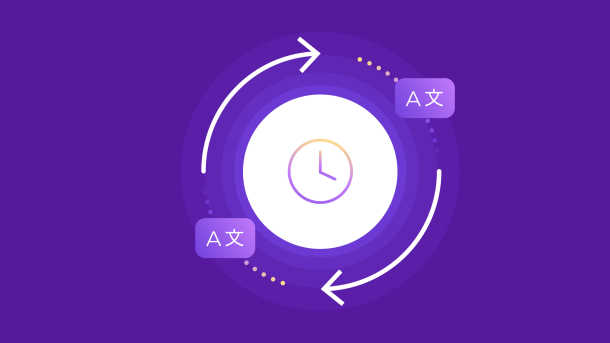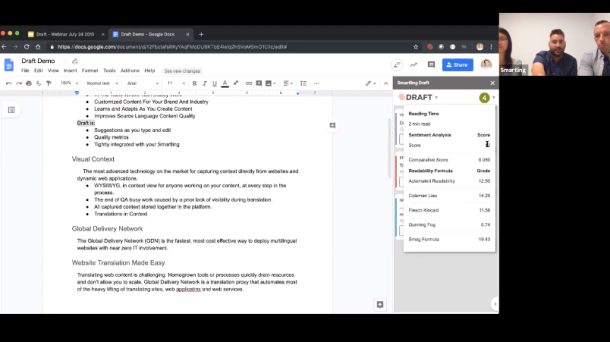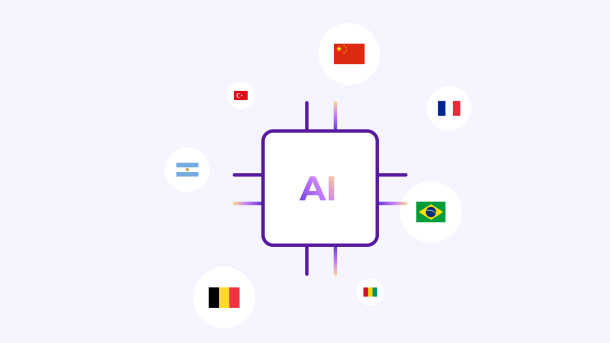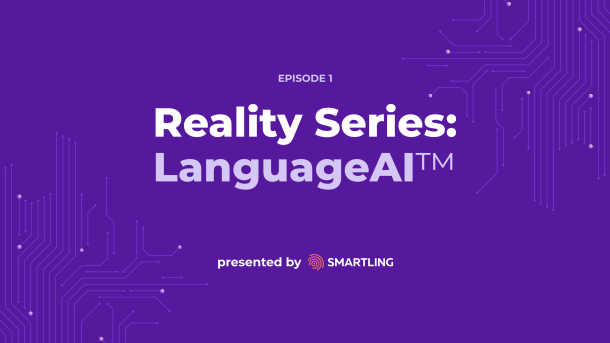Localizing your brand messaging into just 10 languages would allow you to reach 90% of your target market. That’s impressive when you consider that there are no less than 7,000 languages spoken worldwide.
But even localizing content and user experiences into five languages is a huge undertaking. It often involves adapting hundreds of pages worth of website copy, marketing materials, user interface copy, and so on. As you know, this requires a sizeable investment of time, money, and effort with a traditional localization approach.
So, what’s the more efficient approach, and how does it compare to the traditional process?
What artificial intelligence localization is
AI localization uses artificial intelligence (AI) to carry out and automate various aspects of the localization process. Localization is the process of adapting a piece of content's full meaning for a new region or target audience, including translation, associated imagery, and cultural elements that influence how your content will be perceived. The process is all-encompassing and involves adapting the following to ensure clarity, as well as cultural relevance and appropriateness:
- Language
- Messaging
- Brand voice and tone
- Visuals
- User interfaces (for websites, web apps, and software applications)
- Date, time, measurement, and number formats
- Currency and payment methods
Let’s get into where artificial intelligence comes into play here, as well as how it’s beneficial.
What roles does artificial intelligence play in localization?
Artificial intelligence refers to machines or computer systems capable of understanding and emulating human behavior. Two of its main functions are:
- Reducing the manual workload of humans, freeing them up to focus on high-impact tasks that require human expertise
- Enabling faster, more streamlined execution of processes
Within the field of AI, there are three subfields that make the above possible, including on localization projects.
The 3 subfields of AI and their applications in localization
What does AI encompass, and what are some of its localization-related use cases?
1. Machine learning (ML): Machine learning algorithms are trained on extensive data sets that often contain millions of parameters. They use what they learn to make predictions or decisions similar to what a human would—only more efficiently and, in some cases, more accurately.
Machine learning algorithms are the forces behind translation memory and other features commonly found in translation management systems. This includes Smartling’s automated quality assessments, which check for issues like target and source inconsistencies, blocklisted terms, misspellings, and more.
2. Deep learning (DL): Deep learning is a more complex form of ML that enables computers to mimic the way the human brain works. It does this via neural networks, which can process vast amounts of data, identify patterns, and make predictions or take appropriate actions based on analysis.
In the localization industry, neural machine translation (NMT) is a popular application of deep neural networks. Not only can NMT engines understand the meaning and context of a sentence and translate it accurately, but they retain knowledge, enabling them to deliver better translations over time.
Large language models (LLMs) like GPT are also a class of deep learning models that can process and understand natural language data. LLMs are increasingly being used for tasks like pre-editing source text to result in higher-quality translations.
3. Natural language processing (NLP): NLP is the ability of computers to understand and use human language. You’ve seen this machine learning technique at work via fuzzy string matching, which identifies partial matches to previously translated strings (despite spelling variations, typos, abbreviations, and so on).
But an application you may not have seen yet is automated glossary term insertion. Smartling has a unique NLP-powered technology that extracts your custom terminology from your content to facilitate maximum brand relevance across your translations.
These are just a few examples of AI localization. But is AI technology just an optional bell or whistle, or does it really make a difference in the outcomes you can get?
AI localization vs. traditional localization: What are the differences?
Here’s how the two processes stack up.
1. Speed
AI can localize large batches of content in a fraction of the time it would take one or more professional translators. Our Neural Machine Translation Hub, for example, can instantly translate billions of words. So, when it comes to efficiency, AI localization wins more often than not. AI can also speed up other parts of the process:
- Automating the intake of content
- Optimizing source content pre-translation
- Making quality estimations post-translation
With Smartling’s NMT Hub, you can automate 90% or more of your work effort. More than half of our customers automate an impressive 99%+, resulting in both time and cost savings.
2. Cost
Human translation typically costs between $0.15 and $0.30 per word. In contrast, MT is in the range of $0.000010 to $0.000020 per word. To put this in perspective, MT can be the difference between paying $150,000 to translate a million words or paying $10 for the translation and perhaps a nominal additional fee for post-editing and localizing images.
AI is also the driving force behind translation memory. As its name suggests, it memorizes your translated content—brand voice and terminology included—so that you don’t have to pay for the same translations again. At Smartling, we target a minimum of 40% translation memory, which can not only contribute to consistent, high-quality translations but can also reduce costs by almost half.
3. Scalability
Brands are using artificial intelligence to quickly launch into new markets due to the cost-effective, scalable nature of AI. As you know, the traditional process requires a lot of human involvement and manual work, even with CAT tools and the like. This makes it too expensive and/or too time-consuming for many companies to do marketing localization or other types of localization on a larger scale.
4. Personalization
Besides creating efficiencies for brands, artificial intelligence can also be a customer-facing solution. For example, conversational AI chatbots use NLP to understand customer questions or concerns and respond with personalized, human-like messages. There are also AI-powered customer support solutions that translate support tickets and live chat messages.
5. Quality
Quality is one of the top influencers in your decision to leverage AI for localization or not—and rightfully so. There’s definite value in working with native-speaking translators and linguists who have local expertise. They can capture linguistic and cultural nuances that AI technology sometimes can’t. But that’s not to say that artificial intelligence can’t still be useful for adapting content and user experiences for new audiences.
As AI continues to advance, so will its capabilities. Already we’ve seen the quality and accuracy of MT improve with the advances in neural machine translation over the past few years. That will only continue. In the meantime, a balanced viewpoint on leveraging AI is essential. Andrew Batwash, our Associate Director of Language Services, put it this way during our Language AI webinar: “When people talk about AI systems, sometimes they [expect that it] has to be fully automated [with] no kind of human intervention. [But] you can design AI systems to have effective and meaningful human intervention.”
AI systems aren’t meant to replace translators and other professionals involved in the localization process. Andrew says:
“These systems, in a lot of ways, are going to help people be more productive. Their work is going to be more valuable, more meaningful, and it's going to give a better output to customers. Customers are going to realize a lot of efficiencies from an AI system [with humans in the loop].”
The current and future impact of AI on the localization industry
The industry is already seeing the impact of AI described above by Andrew. This technology has enabled all of the following:
- Cost savings thanks to AI-powered solutions like translation memory, translation proxies, and automated quality assessments, all of which are available in Smartling
- Extensive workflow automation with the ability to automate 90% or more of content
- Real-time translation of huge volumes of text with quality steadily increasing as technology advances
As a result, the role of translators is changing. They used to shoulder the bulk of the work with the help of some tools. Now, AI can do much of the work with translators prompting AI on the front end of the process and applying their expertise to polish translations on the back end. So, among the changes in 2023 and beyond, we’ll see a greater demand for post-editing services.
According to the predictions of Olga Beregovaya, our Vice President of AI and Machine Translation, we’ll also see several other changes. AI will be better able to handle mixed- and multi-media formats. Project management roles will evolve to focus more broadly on program management. And there will be a greater focus on diversity, equity, and inclusion initiatives as reducing AI bias continues to be a hot topic.
Leverage Language AI at every step in the localization process
You may have heard the term Language AI swirling around the industry recently. Many think of it as just machine translation. In reality, it encompasses so much more. Because we continue to be at the cutting edge of localization and translation technology, Smartling customers can leverage artificial intelligence across all stages of the localization process. You can do the same.
To see how you can reduce your translation costs by 70%, reduce your workload by 90%, and get up to 350% higher quality translations, check out our 5-minute demo. We’d be happy to chat with you afterward about how to incorporate AI into your workflows and the benefits you can expect from doing so!






